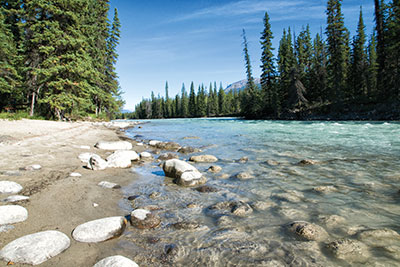
News
Pulling the Plug
B.C. government halts plan for Fraser River gravel removal.
December 2, 2013 By Peter Caulfield
Opposition from local environmental groups plus lack of co-operation
from Mother Nature have meant a B.C. government program to remove gravel
from the lower Fraser River east of Vancouver is dead in the water.
Opposition from local environmental groups plus lack of co-operation from Mother Nature have meant a B.C. government program to remove gravel from the lower Fraser River east of Vancouver is dead in the water.

|
|
This is the third year in a row that gravel removal on the river has not been able to proceed. The 2013 plan had proposed removal of 230,000 cubic metres in the vicinity of Chilliwack, B.C.
“There will be no gravel removed from the Fraser this year for a number of reasons,” said a spokeswoman with Emergency Management BC. EMBC is responsible for removing sediment on the lower Fraser to prevent the river from becoming a
flood danger.
Unlike most Canadian rivers, the Fraser is a mountain river. That means that, for its size, it has an unusually steep gradient and high velocities in flood, which allows it to transport gravel into the Lower Mainland (where Greater Vancouver is located), far beyond where most rivers transport gravel. Localized sediment deposition has raised the river bed over time, creating a flood risk to communities along the river.
“Sediment removal helps to reduce that risk to local communities and is one component of a broader flood protection program,” said the EMBC spokeswoman.
Gravel removal from the Fraser River has not been a major source of work for local contractors. According to the EMBC, only one or two contractors received mining permits in an average year. The significance of the government’s decision is that it shows the strength and reach of the province’s environmental movement.
Like anything in B.C. that can possibly be interpreted as a disturbance to the environment, gravel mining along the lower Fraser River has been controversial. Environmental groups say gravel removal harms fish habitat, because the heavy equipment that is used destroys the spawning beds and refuge areas used by young salmon.
In the fall of 2012, Dr. Mike Church, a retired University of British Columbia professor of geography with an expertise in rivers in Western Canada, was approached to research the issue of gravel mining in the Fraser River.
“I was asked to write and present a report that would summarize my views on the state of the gravel reach of the river [the lower portion of the Fraser], with particular reference to the provincial program to mine gravel for the declared purpose of maintaining the level of flood protection provided by the dykes,” Church said.
In the spring of 2013, Church presented his report, called “Fraser River: Managing the gravel reach/Gravel mining is not the solution.”
The gist of Church’s report is that mining the Fraser for gravel doesn’t help prevent floods, and that the provincial government needs to rethink its strategy.
“Gravel removal from the river has minimal effect on water levels, and therefore it has had minimal effect on managing flood water levels,” he said. “In comparison, channel alignment is the major factor influencing water levels along the river.”
Church said that the rapid pace of development in the Lower Mainland means that a comprehensive plan for the management of the river is urgently needed.
“Otherwise, the valuable resource that it represents may be irrecoverably degraded,” he said.
Church said gravel deposition along the lower Fraser supports the river’s ecology, which contributes economic value through local fisheries and is culturally and economically significant to First Nations.
“With the population of the region projected to grow by more than 40 per cent in the next 25 years, from 2.7 million in 2011 to a projected 3.9 million, the river will more and more become the central element in the maintenance of a liveable environment,” Church said. “All these reasons argue for the maintenance of the river in its natural state, with as little human interference as possible.”
Print this page